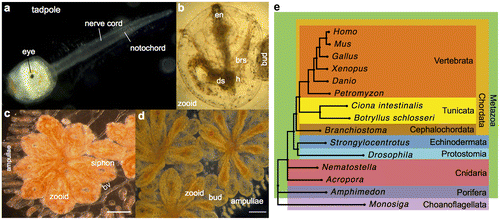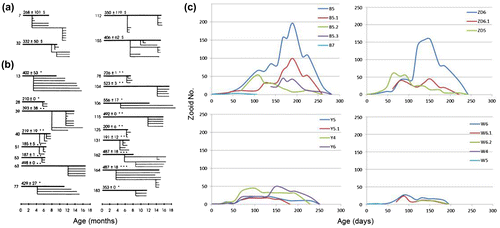Figures & data
Figure 1. B. schlosseri anatomy, life cycle, and phylogeny. B. schlosseri reproduces both through sexual and asexual (budding) pathways, giving rise to virtually identical adult body plans. Upon settlement, the tadpole phase of the B. schlosseri lifecycle (a) will metamorphose into a founder individual (oozooid) (b), which through asexual budding, generates a colony. The colony includes three overlapping generations: an adult zooid, a primary bud, and a secondary bud, all of which are connected via a vascular network (bv) embedded within a gelatinous matrix (termed tunic). The common vasculature terminates in finger-like protrusions (ampullae; b–d). (c). Through budding, B. schlosseri generates its entire body, including digestive (ds) and respiratory (brs) systems, a simple tube-like heart (h), an endostyle (en) that harbors a stem cell niche, a primitive neural complex, and siphons used for feeding, waste, and releasing larvae (b–d). Each week, successive buds grow (d) and complete replication of all zooids in the colony, replacing the previous generation’s zooids, which die through a massive apoptosis. (e) A phylogenomic tree produced from the analysis of 521 nuclear genes (40,798 aligned amino acids) from 15 species, including B. schlosseri. Scale bar-1 mm.
Source: DOI: 10.7554/eLife.00569.003.

Figure 2. Longevity of ramets subcloned from four representative colonies of B. schlosseri undergoing random mortality (a) and the 17 genets expressing synchronized mortality (b). The colony numbers are marked on the left margins of the lines. The original part of each colony is marked by a thick horizontal line; a subclone subcloned from the original part, by a thin line. When more than one subclone was subcloned on a given time, their longevities are marked by parallel horizontal lines. The right-hand end of the horizontal line represents the age at death of each subclone derived from a specific genet. Numbers above each colony represent the average +−SD of all subclones belonging to a specific genet. Levels of significance between the absolute deviation in mortalities of subclones from each genet, compared with the sample mean of the 41 parents genets, are *p < 0.05; **p < 0.01; ***p < 0.001; $, not significant (taken from Rinkevich et al. Citation1992). (c) Growth chart, as measured by zooid number of subclones from four different genotypes studied.

